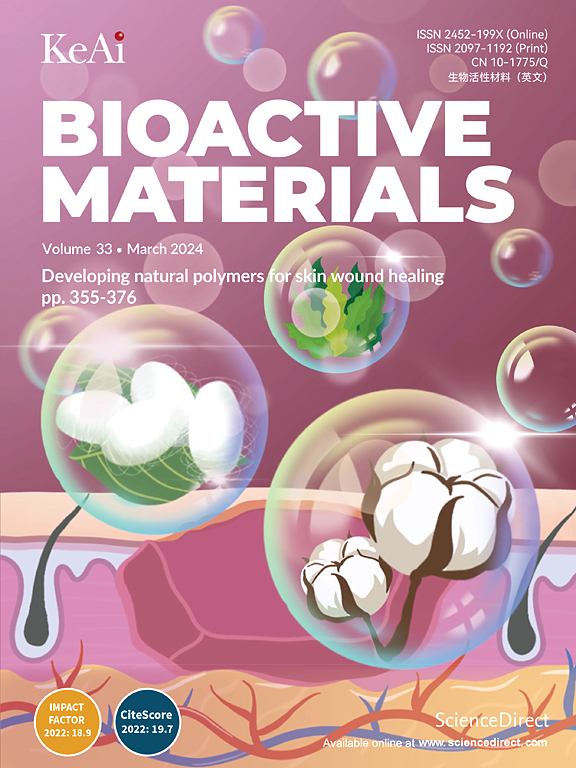Macrophage-targeting Antisenescence nanomedicine enables in-Situ NO induction for Gaseous and antioxidative atherosclerosis intervention
IF 18
1区 医学
Q1 ENGINEERING, BIOMEDICAL
引用次数: 0
Abstract
Senescent-endothelial cells significantly accelerate atherosclerosis progression, making the mitigation of cellular aging a promising strategy for treating the disease. Nitric oxide (NO), a low molecular weight and lipophilic gas, has been shown to penetrate cell membranes effectively and delay cell senescence. In this study, we designed and engineered osteopontin (OPN)-modified nanoliposomes (CZALO) that encapsulate L-arginine (L-Arg) and cerium-zirconium oxide nanoparticles (CZ NPs), which exhibit enzyme-like activities for targeted atherosclerosis treatment. Following inflammatory chemotaxis and OPN-mediated internalization by macrophages, CZ NPs released from CZALO nanoliposomes significantly scavenge reactive oxygen species, thereby inhibiting cholesterol uptake and promoting macrophage phenotypic transformation, resulting in both antioxidant and anti-inflammatory effects. Additionally, nitric oxide synthase (NOS) overexpressed in macrophages catalyzes L-Arg to produce NO, which is then selectively released in situ and diffuses into endothelial cells, exerting anti-aging effects by regulating senescence-associated secretory phenotype factor secretion, enhancing lysosomal function, alleviating cell cycle arrest, and reducing DNA damage. The antioxidant and anti-aging effects of CZALO nanoliposomes collectively alleviate atherosclerotic burden with minimal toxicity both in vitro and in vivo. This “two-birds-one-stone” nanotherapeutic offers a novel approach for regulating vascular microenvironment homeostasis and improving therapeutic efficiency in atherosclerosis treatment.

巨噬细胞靶向抗衰老纳米药物能够原位NO诱导气体和抗氧化动脉粥样硬化干预
衰老的内皮细胞显著加速动脉粥样硬化的进展,使减缓细胞衰老成为治疗该疾病的有希望的策略。一氧化氮(NO)是一种低分子量的亲脂性气体,可以有效地穿透细胞膜,延缓细胞衰老。在这项研究中,我们设计和工程了骨桥蛋白修饰的纳米脂质体(CZALO),它包裹了l -精氨酸(L-Arg)和氧化铈纳米颗粒(CZ NPs),它们具有酶样活性,可用于靶向动脉粥样硬化治疗。经过巨噬细胞的炎症趋化和opn介导的内化,CZALO纳米脂质体释放的CZ NPs显著清除活性氧,从而抑制胆固醇摄取,促进巨噬细胞表型转化,具有抗氧化和抗炎双重作用。此外,巨噬细胞中过表达的一氧化氮合酶(NOS)催化L-Arg产生NO, NO被选择性地原位释放并扩散到内皮细胞中,通过调节衰老相关分泌表型因子分泌、增强溶酶体功能、缓解细胞周期阻滞、减少DNA损伤等发挥抗衰老作用。CZALO纳米脂质体的抗氧化和抗衰老作用共同减轻动脉粥样硬化负担,体外和体内毒性最小。这种“一石二鸟”的纳米疗法为动脉粥样硬化治疗提供了一种调节血管微环境稳态和提高治疗效率的新方法。
本文章由计算机程序翻译,如有差异,请以英文原文为准。
求助全文
约1分钟内获得全文
求助全文
来源期刊

Bioactive Materials
Biochemistry, Genetics and Molecular Biology-Biotechnology
CiteScore
28.00
自引率
6.30%
发文量
436
审稿时长
20 days
期刊介绍:
Bioactive Materials is a peer-reviewed research publication that focuses on advancements in bioactive materials. The journal accepts research papers, reviews, and rapid communications in the field of next-generation biomaterials that interact with cells, tissues, and organs in various living organisms.
The primary goal of Bioactive Materials is to promote the science and engineering of biomaterials that exhibit adaptiveness to the biological environment. These materials are specifically designed to stimulate or direct appropriate cell and tissue responses or regulate interactions with microorganisms.
The journal covers a wide range of bioactive materials, including those that are engineered or designed in terms of their physical form (e.g. particulate, fiber), topology (e.g. porosity, surface roughness), or dimensions (ranging from macro to nano-scales). Contributions are sought from the following categories of bioactive materials:
Bioactive metals and alloys
Bioactive inorganics: ceramics, glasses, and carbon-based materials
Bioactive polymers and gels
Bioactive materials derived from natural sources
Bioactive composites
These materials find applications in human and veterinary medicine, such as implants, tissue engineering scaffolds, cell/drug/gene carriers, as well as imaging and sensing devices.
 求助内容:
求助内容: 应助结果提醒方式:
应助结果提醒方式:


